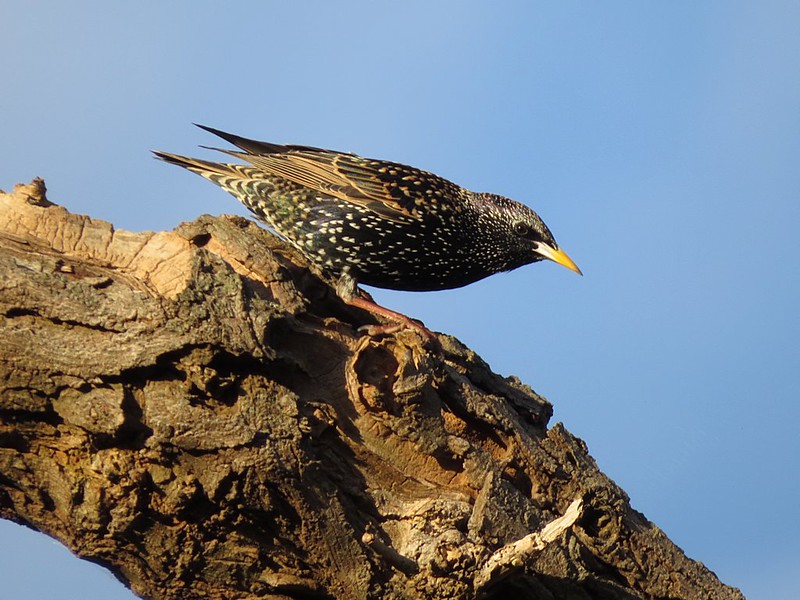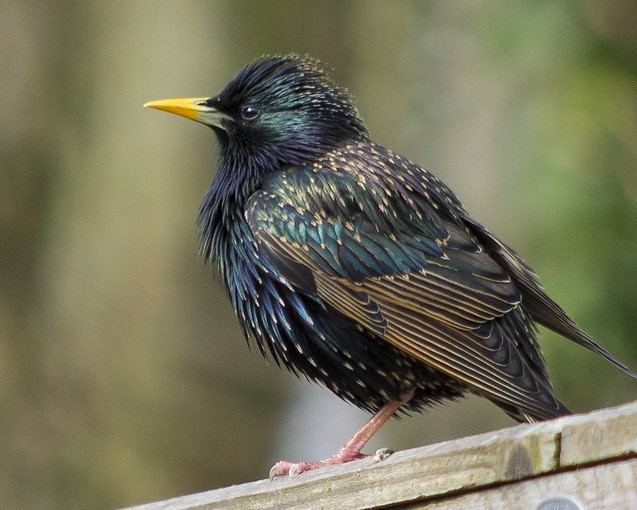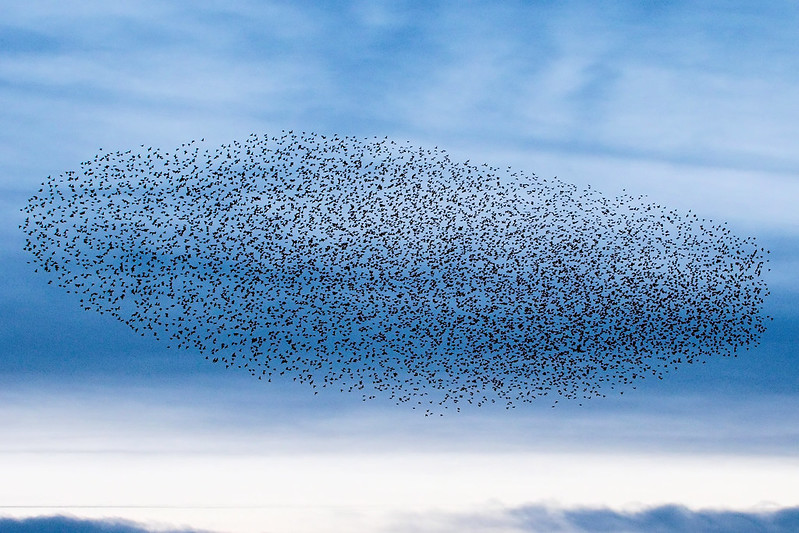 Marking the sixth volume in Stephen Moss’ Bird Biography series, The Starling delves into the fascinating life of one of our most talented and surprising birds. Starlings are renowned for their iridescent plumage, impressive vocal abilities and stunning murmurations, and this captivating tale explores how they’ve shaped our world, inspired art and music through the decades, influenced the agricultural industry and more.
Marking the sixth volume in Stephen Moss’ Bird Biography series, The Starling delves into the fascinating life of one of our most talented and surprising birds. Starlings are renowned for their iridescent plumage, impressive vocal abilities and stunning murmurations, and this captivating tale explores how they’ve shaped our world, inspired art and music through the decades, influenced the agricultural industry and more.
 Stephen is a naturalist, author and broadcaster well known for his work with the BBC Natural History Unit working on landmark programmes such as Springwatch and The Nature of Britain. He currently holds the position of senior lecturer in creative writing at Bath Spa University and is also president of the Somerset Wildlife Trust.
Stephen is a naturalist, author and broadcaster well known for his work with the BBC Natural History Unit working on landmark programmes such as Springwatch and The Nature of Britain. He currently holds the position of senior lecturer in creative writing at Bath Spa University and is also president of the Somerset Wildlife Trust.
Stephen recently took time out of his busy schedule to answer some of our questions about his latest book The Starling, including what inspired him to write about this species, how his opinions of this bird has changed throughout the writing process and more.
The Starling marks the sixth volume in your bestselling Bird Biographies series. What inspired you to turn your attention to Starlings for this latest volume?
I always look for three things when it comes to choosing a subject for a bird biography.
First, does the species show some unusual or specific behaviour or habit which mark it out from other species? For example, the Robin’s habit of singing and holding territory in winter, the Wren’s bizarre breeding behaviour where the male builds several ‘cock’s nests’ for the female to inspect, or the Swallows’ epic migrations.
Second, does it have a strong cultural presence – in music, literature, mythology, popular culture and day-to-day society? Examples include the Robin’s association with Christmas, the Swallow’s position as a herald of spring, the Swan’s royal connections, and the owl’s reputation as a mysterious bird of the night.
And third, does the species relate to both me and the reader? Basically, is it one of Britain’s favourite birds, and if so, why? It also helps if I like the bird and have had a lifelong connection with it – which is true of all the species I have featured in the series so far – as then I can add personal anecdotes from my life as a birder.
Just like the previous subjects in the series – the Robin, Wren, Swallow, Swan, and owl(s), the Starling fits the bill in all three of these categories. It is a very sociable bird – more so than almost any other species during both the breeding season and in autumn and winter, when they gather in those famous murmurations. There are also plenty of historical and cultural references, including the fact that Mozart kept a pet starling which used to whistle his new compositions, and which he mourned in a solemn burial ceremony after it died. Most of all, we have a love-hate relationship with this bird, giving it a real ambivalence in our eyes – which makes it a fascinating subject for a book. And as you mention later on, like most of us, I grew up with Starlings. I now live on the Somerset Levels, just a stone’s throw from the famous winter gatherings, which I have now enjoyed for almost twenty years.

This book explores how starlings have influenced both farming and the arts throughout the years – were there any discoveries that surprised you on this line of inquiry?
The biggest surprise was that the widely known and oft-repeated story that Starlings were introduced into North America by a German emigrant who wanted to bring every bird mentioned in Shakespeare to the New World turns out to be mostly a myth! He wasn’t German (though he did come from a high-ranking New York family of German descent); he had no interest in Shakespeare, and most importantly he wasn’t the first person to release Starlings into the wild in the USA – that happened over 20 years earlier. Check out the chapter on ‘The Global Starling ‘to find out more details!
You mentioned having been around starlings for most of your life in the first chapter. Has your research and writing of this book altered your opinion of these birds?
Definitely! I do have a real soft spot for Starlings – though I also agree with the expert scientist Chris Feare that they look like second-hand car salesmen when they walk! I love the fact that they live alongside us but don’t really care about us – just going along with their day-to-day lives.
I also discovered a lot more about the science of their murmurations, and also about our human response to them, which ranges from loathing to love.
Finally, their ability to adapt to locations around the world where they have been introduced – including South Africa, Australia and New Zealand as well as North America – is also very interesting, and again tells us a lot about our ambivalent attitudes towards these fascinating and often overlooked birds.

Starlings are often regarded with distaste and annoyance by many. Are there any common misconceptions impacting people’s perceptions of this overlooked species? And how can we move towards acceptance, and ideally, appreciation of these birds?
As my old friend and colleague Bill Oddie famously said, people think of Starlings as ‘bird table bullies’! And yet those same people who don’t like them in their garden love watching their spectacular murmurations! They are also often overlooked – like all common, familiar and widespread species, we tend to take them for granted.
Yet paradoxically, as we saw when another common and familiar bird, the House Sparrow, started to go missing from our towns and cities, when we begin to lose a species, we do begin to appreciate them more!
Starlings are in decline, and almost all urban roosts like the ones in the middle of London, including the famous one in Leicester Square that I used to see when I was growing up, are no more. Fortunately roosts in the wider countryside do appear to be making a bit of a comeback.
If anyone still doesn’t like Starlings, I would urge them to come down to Somerset on evenings between November and February, where we still get a quarter of a million or more Starlings murmurating together before going to roost on the Avalon marshes – it really is truly incredible!
How do you think the historical representation of ‘pest species’, such as Starlings, has affected our attitudes towards them, and how do you think we should approach the somewhat controversial topic of conservation vs agriculture vs pest control in the future?
I don’t like the word ‘pest’, though it is at least a bit less loaded than ‘vermin’! As I discuss in the book, Starlings have always been unpopular with farmers, even though they predate on many so-called insect pests in the soil, such as leatherjackets. They do eat fruit and can also cause problems with their droppings, but overall, I think they are less harmful than many people think.
I also believe that we tend to dislike species, especially those that live alongside us, that remind us of ourselves. This includes gulls, crows and of course starlings, which often seem to behave rather like us, and we don’t like that!

I, along with many of your readers, will be excited to see where this series will go next. Have you begun working on the next book? And can you give us any clues as to what comes next?
I have, although I am taking a bit of a break from writing as I am trying to get a better work-life balance and travel to see birds around the world – including Starlings (exotic species in Africa and Asia as well as our own familiar species!). I have long wanted to do the House Sparrow, as it has such a fascinating historical relationship with human beings, and lives closer alongside us than any other species of bird. As a result – just like the Starling – we are very ambivalent towards it.
When we chose the Starling, we had a shortlist of three, the others being Skylark and Kingfisher; yet bizarrely, when I did an X/Twitter poll amongst 2,000 people, the vote split almost exactly to one third for each!
I can’t do some species that readers of the series have suggested, either because, like the Blackbird and Blue Tit, they don’t have very unusual or distinctive behaviour or cultural importance; or because others have already written similar (and excellent) books – such as Sam Lee on the Nightingale and Charles Foster and Sarah Gibson on the Swift.
Currently I am keen on either the Peregrine Falcon or the Puffin, both of which have really strong biological and cultural aspects to their lives – I’d be fascinated to hear which of these species NHBS customers – and your excellent staff – think I should choose!
STEPHEN MOSS is a lifelong birder, broadcaster and bestselling author, whose books have appeared in almost twenty different countries. The Starling is the sixth volume in his celebrated ‘Bird Biographies’ series, following the Robin, Wren, Swallow, Swan, and Owl – and of course The Twelve Birds of Christmas, which featured the dozen species in the famous festive carol. In total these have sold over 100,000 copies, and been translated into Dutch, German and Chinese.
The Starling is available to pre-order from our bookstore here.
